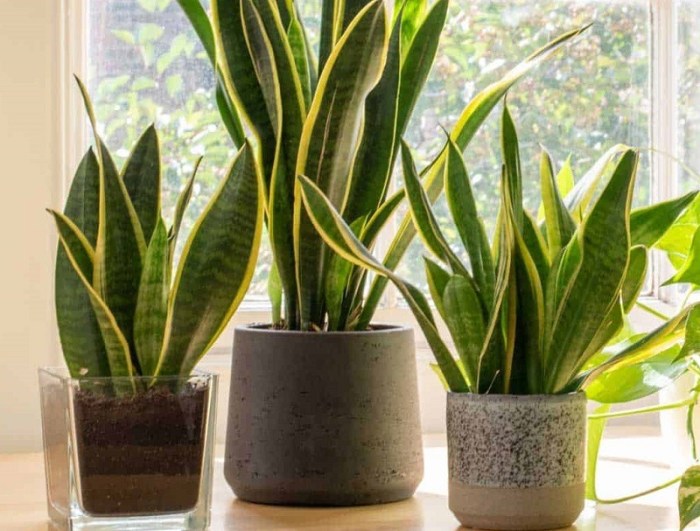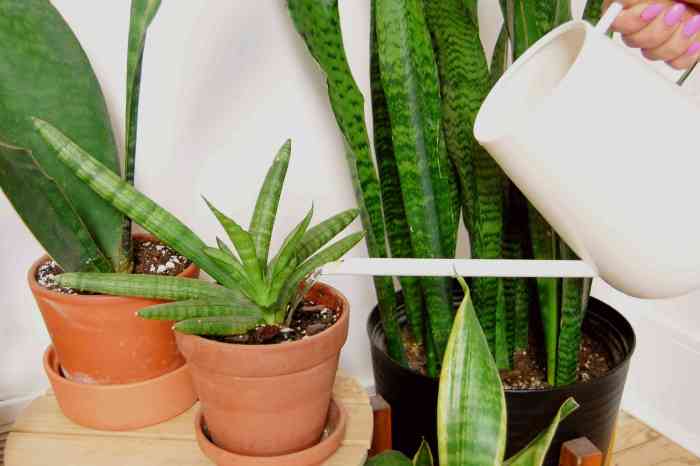How Often Do You Water Snake Plants?
Understanding Snake Plant Watering Needs: How Often Do You Water Snake Plants
How often do you water snake plants – Proper watering is crucial for the health and longevity of your snake plant. Understanding the factors influencing watering frequency, recognizing signs of both underwatering and overwatering, and adapting your approach to different environments are key to successful snake plant care.
Factors Influencing Watering Frequency

Source: patgarden.com
Several factors influence how often you need to water your snake plant. These include pot size, soil type, the season, humidity levels, and the plant’s location.
- Pot Size: Smaller pots dry out faster than larger ones, requiring more frequent watering.
- Soil Type: Well-draining soil is essential. A soil mix that retains too much moisture can lead to root rot.
- Season: Snake plants need less water during the colder months (autumn and winter) and more during the warmer months (spring and summer).
- Humidity: Higher humidity can slow down drying time, reducing the need for frequent watering.
- Location: Plants in direct sunlight will dry out more quickly than those in low-light conditions.
Signs of Underwatering and Overwatering
Recognizing the signs of both underwatering and overwatering is crucial for maintaining a healthy snake plant.
Underwatering:
- Leaves become dry, brittle, and curl inward.
- Soil is completely dry, even several inches below the surface.
- Leaves may appear droopy or shriveled.
Overwatering:
- Leaves become soft, mushy, or yellow.
- Soil remains consistently damp or soggy.
- A foul odor may emanate from the soil.
- Root rot may develop, leading to leaf drop and eventual plant death.
Watering Needs in Different Environments
| Environment | Watering Frequency (Spring/Summer) | Watering Frequency (Autumn/Winter) | Notes |
|---|---|---|---|
| Direct Sunlight | Every 1-2 weeks | Every 3-4 weeks | Monitor soil moisture closely |
| Low Light | Every 2-3 weeks | Every 4-6 weeks | Allow soil to dry completely between waterings |
| High Humidity | Every 2-3 weeks | Every 4-6 weeks | Reduce watering frequency slightly |
| Low Humidity | Every 1-2 weeks | Every 3-4 weeks | Increase watering frequency slightly |
Developing a Watering Schedule
A consistent watering schedule, adjusted based on seasonal changes and plant cues, is vital for healthy snake plant growth.
Sample Watering Schedule, How often do you water snake plants
This is a general guideline; adjust based on your specific environment and plant’s needs.
- Spring: Water every 1-2 weeks.
- Summer: Water every 1-2 weeks, potentially more frequently in hot, dry conditions.
- Autumn: Water every 2-3 weeks.
- Winter: Water every 3-4 weeks or even less frequently, depending on the environment.
Adjusting Watering Based on Plant Cues
Observing your plant’s cues is crucial for fine-tuning your watering schedule.
- Soil Dryness: Insert your finger a couple of inches into the soil. If it’s dry, it’s time to water.
- Leaf Turgidity: Firm, upright leaves indicate adequate hydration. Droopy leaves may signal underwatering, while soft, mushy leaves suggest overwatering.
Importance of Well-Draining Soil
Well-draining soil is paramount. It prevents water from accumulating around the roots, minimizing the risk of root rot, a common cause of snake plant death. A good potting mix will contain a blend of soil, perlite, and other materials to ensure proper drainage.
Watering Methods and Techniques
Several watering methods can be used for snake plants, each with its own advantages and disadvantages. Choosing the right method and mastering the technique is crucial for preventing watering issues.
Comparison of Watering Methods
The most common methods are top watering, bottom watering, and soaking.
Top Watering: Pour water slowly onto the soil surface until it drains from the drainage holes. This is a straightforward method, but can sometimes lead to uneven watering if not done carefully.
- Pour water gently onto the soil surface, avoiding the crown of the plant.
- Allow excess water to drain completely.
- Empty any water collected in the saucer to prevent root rot.
Bottom Watering: Place the pot in a tray of water, allowing the soil to absorb moisture from the bottom. This method ensures even hydration, but can be slower and less convenient.
- Place the pot in a tray filled with a few inches of water.
- Allow the plant to soak for 30-60 minutes.
- Remove the pot from the tray and allow excess water to drain.
Soaking: Completely submerge the pot in a bucket of water for a short period. This is an effective method for deeply hydrating the soil, but requires careful monitoring to avoid overwatering.
- Submerge the pot in a bucket of water for 15-20 minutes.
- Remove the pot and allow excess water to drain thoroughly.
Self-Watering Pots
Self-watering pots offer convenience but require careful monitoring to avoid overwatering. They are best suited for individuals who tend to forget to water their plants regularly, but are not ideal for all snake plant owners.
Addressing Common Watering Issues
Improper watering is a frequent cause of snake plant problems. Recognizing and addressing these issues promptly is essential for plant health.
Common Watering Problems and Solutions
- Yellowing Leaves: Could indicate overwatering or underwatering. Check the soil moisture; if soggy, reduce watering; if dry, increase watering frequency.
- Droopy Leaves: Usually signifies underwatering. Water thoroughly and monitor for improvement.
- Brown, Crispy Leaf Tips: Often caused by underwatering, low humidity, or fluoride buildup in the water. Increase watering frequency, improve humidity, or use filtered water.
- Root Rot: Characterized by mushy, foul-smelling roots and yellowing leaves. Remove affected roots, repot in fresh, well-draining soil, and adjust watering frequency.
Reviving an Underwatered or Overwatered Snake Plant
Underwatered: Gently water the plant, ensuring the soil is thoroughly moistened. Monitor for improvement. Severely underwatered plants may take time to recover.
Overwatered: Remove the plant from the pot, gently remove excess soil from the roots, and allow them to air dry for a few hours. Repot in fresh, well-draining soil and reduce watering frequency significantly.
Troubleshooting Guide
| Problem | Visual Description | Possible Cause | Solution |
|---|---|---|---|
| Yellowing Leaves | Leaves turn yellow, may be soft or mushy | Overwatering or root rot | Reduce watering, repot if necessary |
| Brown, Crispy Tips | Leaf tips become brown and dry | Underwatering, low humidity, fluoride | Increase watering, improve humidity, use filtered water |
| Drooping Leaves | Leaves wilt and droop | Underwatering | Water thoroughly |
| Soft, Mushy Leaves | Leaves become soft and mushy, easily damaged | Overwatering, root rot | Reduce watering, repot if necessary |
Visual Guide to Watering Snake Plants
Healthy, Well-Watered Snake Plant
A healthy, well-watered snake plant displays firm, upright leaves with a vibrant, deep green color. The leaves are plump and smooth, without any signs of wilting or discoloration. The soil is evenly moist but not soggy to the touch. The overall appearance is robust and healthy.
Snake plants are quite drought-tolerant; I usually water mine only when the soil is completely dry, about every 2-3 weeks. Understanding the crucial role water plays in plant health is key to proper watering, so it’s helpful to remember that water facilitates nutrient uptake and turgor pressure, as explained in this article: what does water do to help plants grow.
Therefore, infrequent, thorough watering is best for snake plants to prevent root rot, ensuring their continued health and growth.
Underwatered Snake Plant
An underwatered snake plant shows signs of dehydration. The leaves become dry, brittle, and curl inward. They may appear droopy or shriveled, and the soil is completely dry. The overall appearance is wilted and lacks vitality.
Overwatered Snake Plant

Source: cuttingedgeplants.com
An overwatered snake plant displays soft, mushy, or yellowing leaves. The soil is consistently damp or soggy, and there may be a foul odor emanating from the pot. The plant may exhibit signs of root rot, with decaying roots and leaf drop. The overall appearance is unhealthy and weak.
Ideal Soil Moisture Level

Source: thespruce.com
The ideal soil moisture level for a snake plant is evenly moist but not soggy. The soil should feel slightly damp to the touch, not wet or dry. When you insert your finger a couple of inches into the soil, it should feel slightly moist, not soaking wet or bone dry.
Common Queries
Can I use tap water for my snake plant?
It’s best to use filtered or distilled water, as tap water can contain minerals that may harm your snake plant over time.
How do I know if my snake plant needs repotting?
If roots are growing out of the drainage holes or the soil dries out too quickly, it’s time to repot into a slightly larger container with fresh, well-draining soil.
My snake plant leaves are yellowing. What should I do?
Yellowing leaves can indicate overwatering, underwatering, or poor drainage. Check the soil moisture and adjust watering accordingly. Ensure the pot has adequate drainage.
What type of soil is best for snake plants?
A well-draining potting mix, such as a cactus and succulent blend, is ideal for snake plants. Avoid heavy, clay-based soils.




















